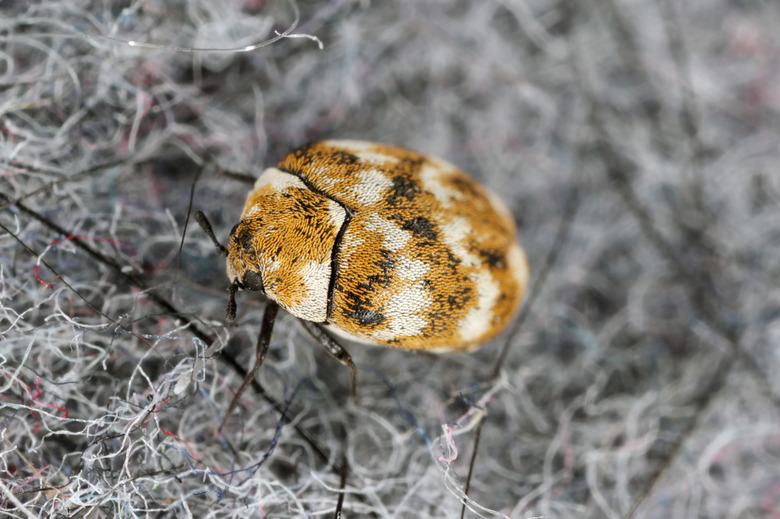How To Kill Worms In Your Carpet
We may receive a commission on purchases made from links.
If you're seeing worms in your carpet, the odds are high that they're not really worms at all but carpet beetle larvae. These larvae can prove difficult to get rid of because they're so versatile. Although adults dine on pollen and plants, which often leads them outside, carpet beetle larvae will eat just about any nonsynthetic material, including wood, cotton, leather, dead skin cells, dry pasta, and silk. This varied diet means that many different areas in your home could be hosting the larvae.
Things Needed
-
Vacuum cleaner
-
Washing machine
-
Clothes dryer
-
Freezer
-
Diatomaceous earth (optional)
-
Window screens (if needed)
How to Kill Worms in Your Carpet
1. Clean and Remove Infested Items
If you see carpet beetle larvae in your carpet, it's important to check other places too. Look for the tiny "worms" in your clothing, paying special attention to wool items. Check curtains, upholstered furniture, plush toys, and other fabrics as well and treat or dispose of them as necessary.
- Vacuum your carpet. Although you should vacuum the entire rug, pay special attention to the edges of the fabric and around baseboards, where carpet beetle larvae tend to hang out. Run the vacuum over curtains and upholstered furniture as well.
- When you're finished vacuuming, remove the vacuum cleaner bag, seal it in plastic, and dispose of it in an outdoor trash can.
- Wash infested clothes in hot water and dry them on high heat when possible. When that is not possible, take the items to a dry cleaner.
- Wrap items you can't wash in plastic bags and freeze them for two weeks. Allow the objects to thaw for at least 24 hours before using them after a freeze, as freezing some items can make them brittle.
- Dispose of items that are completely infested and too far gone to save.
2. Treat With Insecticide
Carpet beetle problems can sometimes be prevented with good housekeeping, but you may need an insecticide treatment to cure an established carpet beetle problem. Insecticides containing cyfluthrin, bifenthrin, deltamethrin, permethrin, and tetramethrin are all effective against carpet beetles. If you prefer to take a more natural approach, you can also use diatomaceous earth.
- Read and follow the directions on your chosen insecticide carefully.
- Test the insecticide on a small and inconspicuous area of your carpet to make sure it won't cause discoloration or damage. Red carpets in particular frequently react with insecticidal agents.
- Pull the edges of the carpet away from the wall. Treat the padding beneath the carpet, the underside of the carpet, and the top of the carpet. Treat your furniture as well. Do not apply insecticides to clothing or bedding. You can, however, treat the area around baseboards and floor edges in your closet.
- Spray some insecticidal dust in any wall voids, cracks, and cervices you find during treatment.
- Set sticky traps on your windowsills to monitor your progress. Adult beetles will fly to the window and get stuck there. If you keep finding adults stuck to the traps, you need to keep cleaning and treating the home.
- Call for backup if necessary. If nothing you try seems to work, call a professional exterminator. They have access to tools and chemicals that you don't and are better equipped to deal with tenacious infestations.
Tip
Note that some sticky traps include pheromones to attract beetles, but they are specific to carpet beetle species. Use them only if you've determined exactly what carpet beetle species you're dealing with.
3. Prevent Future Problems
When your traps are empty and the larvae in your carpets are gone, it's time to do what you can to make sure these tiny insects stay away. There are a few very simple steps you can take to keep carpet beetles at bay.
- Keep the clutter in your home to a minimum. The more stuff you have lying around, the more hiding places carpet beetles have.
- Vacuum your carpet and furniture regularly to keep dirt, dust, dead skin cells, and pet hair from building up and attracting or hosting bugs.
- Store furs, wool, and other delicate garments in airtight containers or plastic garment bags when you won't wear them for long periods of time. Consider storing furs in a cold storage facility.
- Repair or replace any damaged window screens.
